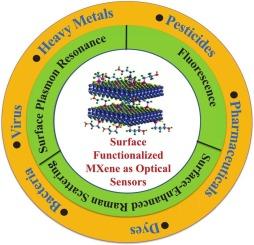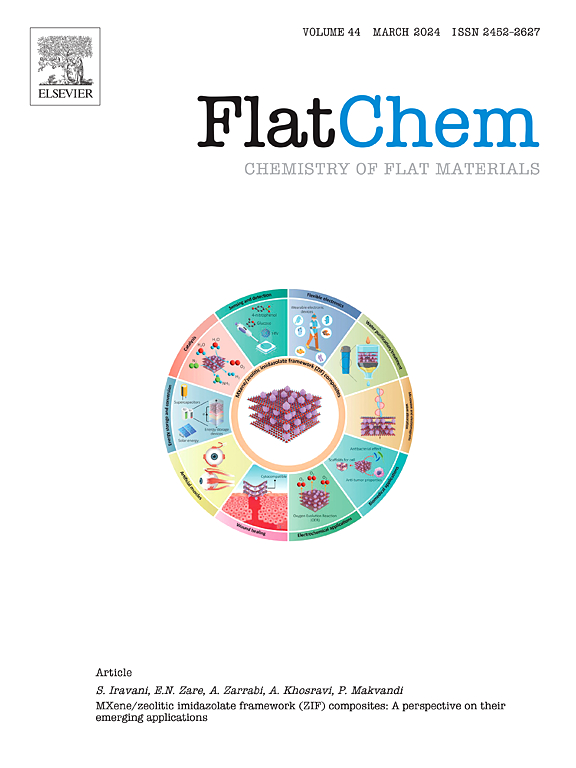表面功能化MXene作为监测化学和生物污染物的新兴二维光学传感器
IF 6.2
3区 材料科学
Q2 CHEMISTRY, PHYSICAL
引用次数: 0
摘要
由于其独特的物理化学性质,包括高表面积、可调表面化学和出色的光学响应,表面功能化MXenes已成为智能光学传感器的极有前途的2D材料。这些特性通过MXenes表面配体的功能化来增强,以提高选择性、灵敏度和稳定性,从而能够精确检测各种环境污染物,如重金属、农药、药物、染料和生物病原体。最近的进展推动了基于荧光、表面等离子体共振(SPR)和表面增强拉曼光谱(SERS)的MXene光学传感器的发展,用于现场和实时监测污染物。本文综述了MXenes在化学和生物污染物检测方面的合成、表征和表面改性的最新进展。关键性能指标,如检测极限,再现性,响应时间和可重用性进行了讨论,以评估传感有效性。最后,概述了基于MXene的传感器在可持续环境监测和法规遵从方面的当前挑战和未来前景,并对基于表面功能化MXene的传感器的各个方面进行了深入讨论。这一全面的讨论为基于MXene传感技术领域的研究人员铺平了道路。本文章由计算机程序翻译,如有差异,请以英文原文为准。

Surface functionalized MXene as emerging 2D optical sensors for the monitoring of chemical and biological contaminants
Surface-functionalized MXenes have emerged as highly promising 2D materials for smart optical sensors due to their unique physicochemical properties, including high surface area, tunable surface chemistry, and excellent optical response. These features are enhanced by functionalization of ligands on the surface of MXenes to improve the selectivity, sensitivity, and stability, enabling precise detection of various environmental contaminants such as heavy metals, pesticides, pharmaceuticals, dyes, and biological pathogens. Recent advances have driven the development of fluorescence, surface plasmon resonance (SPR), and surface-enhanced Raman spectroscopy (SERS) based MXene optical sensors, for onsite and real-time monitoring of pollutants. This review highlights the latest progress in synthesis, characterization, and surface modification of MXenes, for the detection of chemical and biological contaminants. Key performance indicators such as limit of detection, reproducibility, response time, and reusability are discussed to evaluate sensing effectiveness. Finally, current challenges and future prospects for MXene-based sensors in sustainable environmental monitoring and regulatory compliance are outlined, offering an in-depth discussion of every aspect of surface functionalized MXene based sensors. This comprehensive discussion paves the way for researchers working in the field of MXene based sensing technology.
求助全文
通过发布文献求助,成功后即可免费获取论文全文。
去求助
来源期刊

FlatChem
Multiple-
CiteScore
8.40
自引率
6.50%
发文量
104
审稿时长
26 days
期刊介绍:
FlatChem - Chemistry of Flat Materials, a new voice in the community, publishes original and significant, cutting-edge research related to the chemistry of graphene and related 2D & layered materials. The overall aim of the journal is to combine the chemistry and applications of these materials, where the submission of communications, full papers, and concepts should contain chemistry in a materials context, which can be both experimental and/or theoretical. In addition to original research articles, FlatChem also offers reviews, minireviews, highlights and perspectives on the future of this research area with the scientific leaders in fields related to Flat Materials. Topics of interest include, but are not limited to, the following: -Design, synthesis, applications and investigation of graphene, graphene related materials and other 2D & layered materials (for example Silicene, Germanene, Phosphorene, MXenes, Boron nitride, Transition metal dichalcogenides) -Characterization of these materials using all forms of spectroscopy and microscopy techniques -Chemical modification or functionalization and dispersion of these materials, as well as interactions with other materials -Exploring the surface chemistry of these materials for applications in: Sensors or detectors in electrochemical/Lab on a Chip devices, Composite materials, Membranes, Environment technology, Catalysis for energy storage and conversion (for example fuel cells, supercapacitors, batteries, hydrogen storage), Biomedical technology (drug delivery, biosensing, bioimaging)
 求助内容:
求助内容: 应助结果提醒方式:
应助结果提醒方式:


